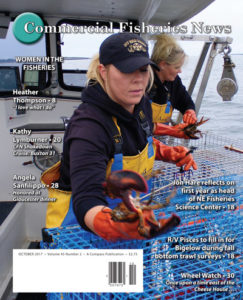The changing of the seasons (and the sea) remind us every year of changes we want or need to make in our daily and work lives. Actually our risks change with the seasons.
We get out our jackets to resist the cold, sand and salt to keep from slipping on the ice, and thicker gloves for deck work to prevent frost bite.
While I was looking for some recent marine alerts related to fishing vessels in the UK, I came across the Code of Practice for the Safety of Small Fishing Vessels, developed by The Maritime and Coastguard Agency and effective as of Jul. 16, 2007.
The code applies to UK-registered fishing vessels with a length overall (LOA) of 15 meters or less – roughly less than 50’.
What is interesting about this Code of Practice is the requirement for an annual self-certification.
After the owner completes the checks specified in three self-certification steps, within one month of the vessel’s registration, he/she must complete, sign and date a certification document that is kept on board pending inspection by the Marine and Coastguard Agency (MCA).
The owner must certify that:
• “Safety equipment carried on board the vessel has been suitably maintained and serviced in accordance with the manufacturer’s instructions;
• “Safety and other specified equipment continues to comply with the checklist, appropriate to the length and construction of the vessel; and
• “Health and safety risk assessment has been completed.”
Step 1 of the self-certification process covers EPIRBs, liferafts, immersion suits, and any other equipment that requires servicing.
Step 2 refers to items that are listed in the appendix under length headings, such as open vessels less than seven meters registered length; open vessels 7m to less than 12m; etc. These items include lifejackets, lifebuoys, flares, smoke signals, a fire bucket, fire extinguisher, fire blanket (if galley present), VHF radio (DSC,) and other items.
In the US, fishing vessel owners would probably be able to easily complete the portion of certification required by these first two steps.
The step we are unfamiliar with is Step 3 – a health and safety risk assessment.
 First, how is it that UK fishermen know how to do this assessment?
First, how is it that UK fishermen know how to do this assessment?
The answer lies in the following table of required training courses. (See accompanying chart, Fig. 1.) UK fishermen are required to have training in safety awareness and risk assessment and thus know how to proceed to address Step 3.
*Experienced Fishermen are those with not less than two years of onboard fishing work.
The Marine Guidance Note (MGN 20 M+F) offers extensive information for creating the risk assessment.
Seafish.org provides a standard for a written risk assessment, should the owner decide to create a written document which is recommended but not required by MCA.
At the website www.seafish.org one can find a Fishing Vessel Safety Folder.
The scope of the risk assessment, as outlined in the code, is meant to be “a careful examination of what, in the nature of operations could cause harm, so that decision can be made as to whether enough precautions have been taken…”
 The vessel owner should identify the hazards (a potential harm), categorize the likelihood that the hazard may happen, describe the consequences, and specify how the risk is reduced.
The vessel owner should identify the hazards (a potential harm), categorize the likelihood that the hazard may happen, describe the consequences, and specify how the risk is reduced.
What might this risk assessment self-report look like for the lobstering industry in the winter? (See accompanying chart, Fig. 2.)
FISH SAFE:
• Consider reflecting on the hazards in your work environment and work practice.
• Play out mental, or write-up, scenarios about the risks and how to reduce them.
• Take a look at the websites listed here:
The Fishing Vessels Code of Practice for the Safety
of Small Fishing Vessels. Available at <https://www.gov.uk/government/uploads/system/uploads/attachment_data/file/406106/Draft_Small_Fishing_Vessel_Code.pdf>
Implementation of EC Directive 89/391 MERCHANT SHIPPING AND FISHING VESSELS (HEALTH AND SAFETY AT WORK) REGULATIONS 1997. Available at <https://www.gov.uk/government/uploads/system/uploads/attachment_data/file/282356/mgn020.pdf>
To get access to more great content – you’ll need to purchase the
OCTOBER 2017 issue of Commercial Fisheries News.
Please choose from the following options:
• BUY a Single PRINT edition of CFN that is delivered by MAIL. PRINT EDITION
• Quickly enjoy ONLINE access with our Hi-DEF flip-book. PURCHASE THIS ONLINE EDITION
• Shop the Online ARCHIVE
(Read online flip-book immediately with purchased access key and download a copy for yourself to keep.
Not sure if it works for you? Try a FREE SAMPLE HERE.)
• SAVE BIG when you SUBSCRIBE!






